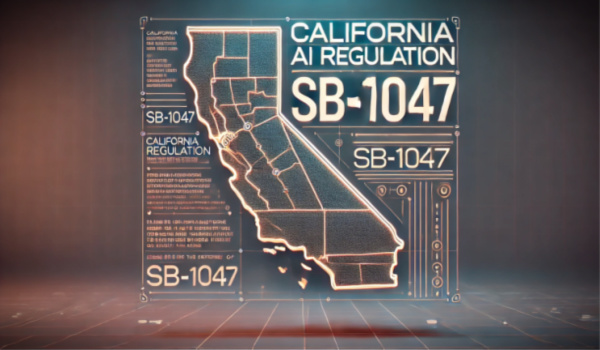By Greg Woolf, AI RegRisk Think Tank
California, often at the forefront of technological innovation, is now at the center of a heated debate over its proposed AI regulation (SB 1047). This bill seeks to impose safety checks and shutdown capabilities on AI models, and has sparked intense controversy. Supporters argue that it provides necessary guardrails to prevent catastrophic harm, while critics warn that it could stifle innovation and drive AI development out of the state and possibly the country.
A Fine Line Between Safety and Stagnation
At the heart of SB 1047 is a bold move to impose stringent safety tests on large AI models to mitigate what the bill terms “catastrophic harm.” We’re talking about scenarios like cyberattacks that could result in mass casualties or cause significant economic damage. Sound far-fetched – how about the CrowdStrike outages which topped $5bn in damages and caused untold disruption to travelers and consumers just last month! The bill also mandates that AI systems come equipped with a “kill switch” that allows human operators to shut them down in emergencies – not a bad idea but difficult to implement in a distributed processing environment like the cloud.
Proponents, including some of the most respected voices in AI safety, argue these measures are not just prudent but essential. They insist that the AI industry, left to its own devices, is a ticking time bomb, with the potential for misuse that could result in unprecedented harm. The bill, they say, targets only the largest and most dangerous AI models, setting in stone safety standards that many companies already claim to follow voluntarily.
But the critics aren’t buying it. Tech industry leaders, venture capitalists, and academic institutions argue that SB 1047 is a wolf in sheep’s clothing—a bill that, under the guise of safety, could devastate innovation. They warn that the bill’s emphasis on hypothetical, existential risks—think AI-triggered extinction events—over tangible, measurable harms, could foster a regulatory environment that’s driven more by science fiction fears than by facts.
Industry Divided
Yoshua Bengio and Geoffrey Hinton may not be household names, but in the AI world they are giants. Bengio co-pioneered deep learning, the technology that underpins much of modern AI, while Hinton’s work on neural networks serves as the backbone of many AI systems today. Both Bengio and Hinton have thrown their weight behind SB 1047, calling it the “bare minimum” for responsible AI regulation. They argue that, given the potential dangers AI poses, even the strictest regulations are not only justified but necessary.
On the other hand, many in the tech community see SB 1047 as nothing short of overreach. They argue that its provisions could disproportionately harm smaller companies and open-source projects, which lack the resources to navigate these new regulations. There’s also growing concern that the bill could drive AI research and development out of California and ultimately the USA altogether, handing a competitive advantage to regions like China where regulatory environments are lacking.
We Need a Better Definition of AI Risks
Critics are also taking aim at the bill’s reliance on what they see as unproven assumptions about AI risks. The Deputy Director at the Stanford Institute for Human-Centered AI argues that the bill is misguided, focusing too much on existential risks, or “x-risks” (like the AI-driven extinction of humanity), while ignoring the immediate, tangible harms that AI already causes. This is where the real friction lies.
A growing number of AI experts are pushing back against this “doomer” narrative, urging lawmakers to focus on the real, measurable dangers of AI, such as bias and misinformation. By chasing after far-fetched scenarios, they argue, the bill risks missing the forest for the trees, neglecting to address the very real and present harms that AI could inflict.
The Larger Debate: Precaution vs. Progress
The controversy surrounding SB 1047 isn’t just about the specifics of AI regulation; it’s a microcosm of the larger debate about how governments should manage technological innovation. On one side are those who champion the precautionary principle—the belief that it’s better to regulate potentially dangerous technologies before they can cause harm. On the other are those who argue that innovation should be given room to breathe, with minimal interference, trusting that the benefits will outweigh the risks.
Conclusion: A Critical Moment for AI Regulation
At its core, SB 1047 lacks a clear “Definition of Harm.” Critics argue that the bill is too vague, leaving too much room for interpretation, which could lead to inconsistent enforcement and uncertainty for AI developers. However, most agree that some form of AI governance is necessary. Establishing a concrete, measurable definition of practical and measurable harms from misguided or malicious AI would provide a clearer framework for regulation, making it easier to assess risks and enforce standards. Such a definition would be critical for any effective risk management program, ensuring that regulations are both fair and effective.
SB 1047 represents a critical moment in the ongoing discussion about AI regulation. The bill’s fate will likely have far-reaching consequences for the AI industry, influencing how AI is developed and deployed for years to come. Whether you see SB 1047 as a necessary safeguard or a potential roadblock to progress, one thing is certain: the conversation around AI regulation is only just beginning.
 Greg Woolf is an accomplished innovator and AI strategist with over 20 years of experience in founding and leading AI and data analytics companies. Recognized for his visionary leadership, he has been honored as AI Global IT-CEO of the Year, received the FIMA FinTech Innovation Award, and was a winner of an FDIC Tech Sprint. Currently, he leads the AI Reg-Risk™ Think Tank, advising financial institutions, FinTech companies, and government regulators on leveraging AI within the financial services industry. https://airegrisk.com
Greg Woolf is an accomplished innovator and AI strategist with over 20 years of experience in founding and leading AI and data analytics companies. Recognized for his visionary leadership, he has been honored as AI Global IT-CEO of the Year, received the FIMA FinTech Innovation Award, and was a winner of an FDIC Tech Sprint. Currently, he leads the AI Reg-Risk™ Think Tank, advising financial institutions, FinTech companies, and government regulators on leveraging AI within the financial services industry. https://airegrisk.com







